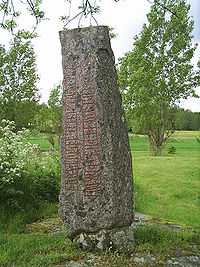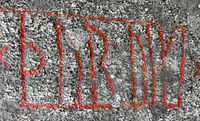Velanda Runestone
| Velanda Runestone | |
|---|---|
 | |
| Rundata ID | Vg 150 |
| Country | Sweden |
| Region | Västergötland |
| City/Village | Velanda |
| Produced | probably the early eleventh century |
| Runemaster | unknown |
Text - Native | |
| Old Norse : See article. | |
| Text - English | |
| See article | |
| Other resources | |
|
Runestones - Runic alphabet Runology - Runestone styles | |
The Velanda Runestone, designated as Vg 150 in the Rundata catalog, is a runestone that is dated from the late tenth century or the early eleventh century and which is located in the village of Velanda, Trollhättan Municipality, Västra Götaland County, Sweden, which is in the historic province of Västergötland.
Description
The Velanda Runestone is inscribed in Old Norse with the Younger Futhark. Above the arch of the runic text band is the outline of an eagle head facing to the left.[1] The stone was raised by a woman named Þyrvé in memory of her husband Ögmundr. The runic inscription states that he was miok goðan þegn or "a very good thegn." The exact role of thanes in southern Sweden is a matter of debate, but the most common view is that these persons constituted a Nordic elite somehow connected to Danish power. It is thought that thane-stones point to areas where they came from. From such power centers they could be sent forth to rule border areas in so called tegnebyar.[2] About fifty other runestones refer to the deceased being a thegn. Of these, four other runestones use exactly the same phrase, miok goðan þegn: Vg 73 in Synnerby, Vg 108 in Tängs gamla, Vg 137 Sörby, and DR 99 in Bjerregrav.
The inscription asks the Norse pagan god Thor to hallow the runestone. There are two other runestones that have similar invocations to Thor located in Sweden include Ög 136 in Rök and Sö 140 in Korpbron.[3] Other runestones in Denmark that include invocations of or dedications to Thor in their inscriptions include DR 110 from Virring, DR 209 from Glavendrup, and DR 220 from Sønder Kirkeby.[4] It has been noted that Thor is the only Norse god who is invoked on any Viking Age runestones.[5]
This runestone was discovered by a farmer named Jacobsson around 1910.[6] It is known locally as the Velandastenen.
Inscription
Transliteration of the runes into Latin characters
- × þurui : risþi : stin : iftiR : ukmut : buta : sin : miuk : kuþan : þikn × þur : uiki ×[7]
Transcription into Old Norse
- Þyrvi ræisti stæin æftiR Ogmund, bonda sinn, miok goðan þegn. Þorr vigi.[7]
Translation in English

- Þyrvé raised the stone in memory of Ôgmundr, her husbandman, a very good Þegn. May Þórr hallow.[7]
References
- ↑ McKinnell, John; Simak, Rudolf; Dwel, Klaus (2004). Runes, Magic and Religion: A Sourcebook. Vienna: Fassbaender. pp. 120–121. ISBN 3-900538-81-6.
- ↑ Löfving, Carl (2001). Gothia som Dansk/Engelskt Skattland: Ett Exempel på Heterarki Omkring år 1000 (doctoral dissertation). Göteborg.
- ↑ Sawyer, Birgit (2000). The Viking-Age Rune-Stones: Custom and Commemoration in Early Medieval Scandinavia. Oxford University Press. p. 128. ISBN 0-19-820643-7.
- ↑ McKinnell, John (2005). Meeting the Other in Norse Myth and Legend. Cambridge: D. S. Brewer. p. 117. ISBN 1-84384-042-1.
- ↑ Page, Raymond Ian (2001 (1990)). Norse Myths. University of Texas. p. 41. ISBN 0-292-75546-5. Check date values in:
|date=(help) - ↑ Flom, George T. (1916). "Scandinavian Publications, Recent and Forthcoming". Publications of the Society for the Advancement of Scandinavian Study 3. Society for the Advancement of Scandinavian Study (U.S.). p. 226.
- ↑ 7.0 7.1 7.2 Project Samnordisk Runtextdatabas Svensk - Rundata entry for Vg 150.
Other sources
- Larsson, Mats G. (2002). Götarnas Riken : Upptäcktsfärder Till Sveriges Enande. Bokförlaget Atlantis AB ISBN 978-91-7486-641-4
External links
- Photograph of runestone - Swedish National Heritage Board